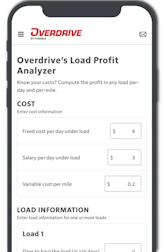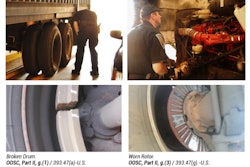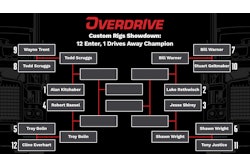Historically, owner-operators have been religious about changing oil in their trucks at low-mileage intervals. At the same time, advancements in engine and oil technologies have allowed engine manufacturers to dramatically increase recommended drain intervals. They vary from manufacturer to manufacturer, but all OEMs are basing interval recommendations in part on fuel mileage.
Cummins, for example, recommends drain intervals of up to a whopping 75,000 miles if you’re able to squeeze more than 7 miles per gallon out of its X15 engine. That interval drops to 60K miles if your mileage is in the 6-mpg range. If you’re getting 5-5.9 mpg, oil changes are recommended every 50K miles, 25K miles for more severe-duty applications with sub-5 mpg averages.
Variations by manufacturer are minimal across the board. Detroit, Paccar, Volvo and Mack all have similar recommendations depending on duty cycle. None recommend intervals longer than 75K miles for the most efficient operations, and none less than 25K for the toughest applications.
If you needed another reason to strive for better miles per gallon of diesel burned, the maintenance savings from extended drains could provide the spark. Yet Overdrive's recent surveying on the subject shows truck owners' drain intervals holding fast to tried-and-true practices. Most owner-operators clearly live by the old “oil is cheap, engines aren’t” adage.

As shown, more than half of readers change at intervals at or below 15,000 miles -- well below manufacturers’ recommendations for even the toughest of duty cycles for newer equipment. Just more than a third of respondents land between 15,000 and 50,000 miles, and just 9% of operators are extending intervals beyond that mark.
Yet talking to owners across the nation, it's clear attitudes around extended drains are changing. More liberal approaches to drain intervals, at once, come with a dose of old-school approaches that bet on returns in long-term engine health from staying below recommended intervals.
[Related: Owner-operator reaps 10-plus-mpg rewards of decades learning, growing]
Drain-approach change, little by little
Owner-operator David Foster, who runs leased to Standard Transportation Services in his Joplin, Missouri, hometown, has been following the fuel mileage-based recommendation from the OEMs for a number of years, he said. His 2005 Kenworth W900 is powered by an Acert Cat, but a prior truck he owned around the turn of the century was equipped with a Cummins ISX -- “the best fuel-mileage truck I ever had,” he said. “When I had that ISX Cummins, they recommended going by fuel mileage, which kind of made sense a little bit.
"If you’re getting very good fuel mileage, you’re not wearing [the engine] as much” as you might otherwise.
 Owner-operator David Foster
Owner-operator David Foster
With that particular vintage of ISX, the recommendation was to go as high as 40K miles between oil changes, he said, which he did. Today with his Cat, he’s typically changing oil around 20K-25K miles.
“I’ve still got friends that do immediately 10 [thousand miles] still, [but] I feel 20-25 is sufficient,” he added.
Longtime small fleet owner-operator Scott Cruthis, now co-owner of 2025 Overdrive Small Fleet Champ Thomasville Furniture Xpress, takes intervals a little farther to 40K miles for the near-30-truck fleet of very-new International LTs and some older Peterbilt 579s and other models. He pairs that full drain interval with a full greasing every 10K miles, and oil- and fuel-filter changes halfway through the interval at 20K. He'd traditionally been "old-school" like so many owner-operators, he said, about maintenance. "I always did 15,000" for a full drain interval.
Yet he's using full-synthetic oil in the later model equipment these days. Two of the 579s he brought to TFX from his prior small fleet, both since sold, marked the start of his slightly more new-school approach.
At the time he bought them, "they recommended going 60,000 miles on the Paccar engine," he said. Cummins' recommendation depended on the fuel mileage, he added. Getting six mpg, change earlier. Seven, longer. "I just settled on 40K to be conservative. They'd recommended 25K for changing the fuel filters." He went with 20K and has been heartened by the results.
Among older models still in the TFX fleet is a 2014 Paccar-powered 579 with 1.3 million miles on it without an overhaul as yet.
[Related: LTL furniture specialist TFX lays solid ground for growth, profit, support]
Tennessee-based independent owner-operator Brandon Scates runs a 2024 Kenworth W900 powered by a 565-hp Cummins. He's part of the group of owners who drain their oil every 50,000 miles. Scates’ current rig is his “second DEF burner, and I read the operator’s manual when I bought the truck,” which contains the fuel-mileage-based recommended intervals.
“I stay above 6 [mpg] on my truck, and so that was telling me that you could go about 60,000 miles, which was kind of foreign to me,” he said.
To ease his concerns about such a long interval, he decided to implement oil sampling and analysis. At 25,000 miles, he pulls an oil sample and ensures it’s still running clean, then at 50,000 miles, he pulls another sample “to look at the oil that I’m dumping.”
Scates uses synthetic oil and, based on his observations, probably could run his oil longer than 50,000 miles.
“If you believe in the numbers, I believe you can keep going” before changing the oil, he said. For his operation, though, he prefers to stick to an interval he’s comfortable with.
 Owner-operator Brandon Scates
Owner-operator Brandon Scates
2023 Overdrive Trucker of the Year Jay Hosty famously took belief in those analysis numbers to a 100,000-mile drain interval conclusion, pushing the very limits of oil drains with sampling and analysis every 20,000 miles, accompanied by filter changes. "If the sample came back good, I'd leave the oil in and I would go 100,000 miles on the same oil and it's not even synthetic," Hosty said at the time. He was using Mobil Delvac 15W40 "straight mineral oil. ... I don't ever remember [analysis reports] coming back saying that the oil needed to be changed, but I would just do it there," at 100K miles. "I'd just say, 'OK, that's enough.'"
Mind you, Hosty executed the experiment to success with a pre-DPF/DEF engine in a 2006 Western Star. Such long intervals in emissions-equipped units might be more difficult to pull off, yet as some forward-thinking owner-operators are showing, operational practices can pay dividends for longer-term oil life.
TFX's Scott Cruthis knows a lot can depend on just how often filters are changed and, crucially, he said, the amount the truck's idled. Idling he calls "about the worst thing you can do" for emissions equipment.
[Related: Pull off extended oil drains for your diesel with routine analysis]
Read next in this two-part examination of oil drain interval practices: What owner-ops are doing to extend oil drains: Idling reduction is paramount














